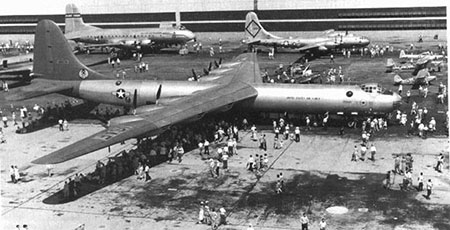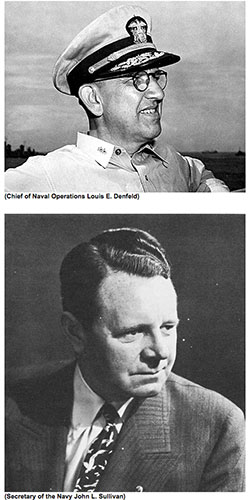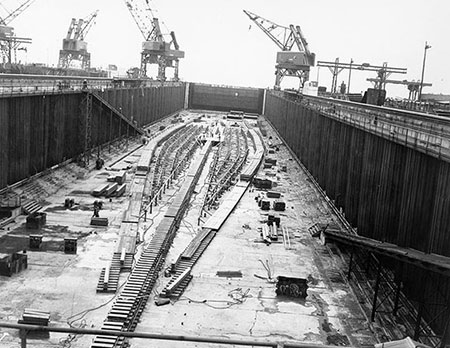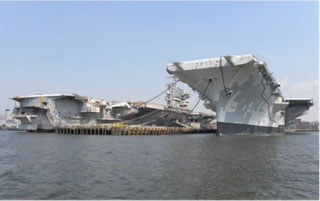The Revolt of the Admirals

(Convair B-36 Peacemaker, 1949. My brother and I stopped at Wright-Patterson AFB to see the one in the Air Force Museum. It is one of the most extraordinary aviation artifacts I have ever seen. Official Air Force picture.)
“The Bomb got us all home,” said Mac. “It saved us the hundreds of thousands of casualties, American and Japanese, that would have come if we had executed Operation OLYMPIC. That is certain. But once the bomb was used, the genie was out of the bottle.” Mac looked down at his ginger ale a little pensively.
“James Forrestal began to agitate about the threat from the Soviets while the war was still raging. He visited Ike in England during the war to emphasize his concerns about the Soviets. Apparently Ike agreed with him, though he had to walk the line in the Alliance. The Soviets had sacrificed so much, on the East Front it was difficult not to accept that they had a moral justification for what they were doing to Germany.”
“And it was better for German and Russian kids to die for their countries than ours. Didn’t Patton say something like that?”
Mac grimaced at my paraphrase of the quote from Old Blood and Guts. “Victory is victory. But Forrestal certainly was proven right by the Communist political campaigns against the elected governments of Greece, Italy, and France after the war. The Truman Administration did not agree with Forrestal’s concerns, though that was what drove Naval Intelligence to begin to track what the Soviets were up to. It was still the deepest secret in the OPINTEL business that our former Allies were the most important target. It was at the heart of everything in the struggle about unification of the services.”
“So what was it like?” I asked. “Was the controversy as big as when Secretary Gates suggested eliminating the Marine Corps?” I could feel the effect of the happy-hour-priced pinot grigio and my scrawl in the notebook was getting wilder and wilder. Peter offered to top me off, and I put my hand over the top of the glass. This was important and I wanted to get it straight. I wanted a cigarette, too, but those days are long gone in Virginia’s bars and restaurants, as gone as the 1940s.
“You have no idea. Now, remember I was just a fresh-caught Lieutenant Commander then, but there were some amazing shenanigans here in Washington. It wound up in 1949 with the firing of the SECNAV and the CNO.”
“Wow. You said it was about the budget more than anything.”
“Of course. Everything here is driven by money. Anyone who tells you it is not the green-eyeshade crowd that drives strategy is a fool. The “Revolt” had been building for several years, but it climaxed the year we moved Y-Branch to the Armed Forces Security Agency at Arlington Hall Station.

“The drive for unification began in 1943, and the National Security Act of 1947 made it formal. The generals of the new Air Force announced that strategic bombing, particularly with nuclear weapons, was the sole decisive element necessary to win any future war; and was therefore the sole means necessary to deter an adversary from launching a Pearl Harbor like surprise attack or war against the United States.”
“That is a breathtaking assertion,” I said. “Like some of the things Secretary Rumsfeld used to say.”
“Well, it certainly was a transformational doctrine. The Air Force ladership proposed that it should be funded by the Congress to build a large fleet of long-range strategic heavy bombers, beginning with the B-36 Peacemaker bomber.”
“I have seen the one they have at Wright-Patt Air Base. It is impressive.”
“You can imagine that SECNAV Forrestal was opposed to that, and he continued to oppose it when he became the first SECDEF. The Navy’s position was that the triumph of the aircraft carriers in the Pacific War demonstrated the importance of fielding a new class of super-carriers, the first of which was to be the USS United States.”
“So the fight was between weapons systems? I said.
“Only so much money to go around,” said Mac. “Something had to give, and when Truman appointed Louis Johnson to replace Forrestal, the balance shifted to the Air Force. The Navy leadership believed that wars could not be won by strategic bombing alone, and that preemptive use of the A-bomb was immoral.”

(USS United States, pictured in drydock with her keel laid. Official Navy Photo)
“Though the carrier would have carried atomic weapons, of course.”
“Of course,” said Mac. “Less than a after he too office, and without consultation with the Congress, he cancelled the United States. Then he announced that all the aircraft in the Marine Corps would be transferred to the Air Force, just as the Army’s had.”
“Good golly. That must have caused an uproar in Congress.”
“It did, and several admirals resigned in protest. See, the Air Force could not control Naval Aviation, and Johnson sought to shut down procurement of new platforms not controlled by the blue-suiters.”
“Obviously the Navy couldn’t take that laying down,” I said indignantly.
Mac clasped his hands. “They didn’t. A little group called OP-23 was stood up by 31-knot Burke, the destroyer hero from the Southwest Pacific. Arleigh was just a Captain then, and the group began to quietly collect operational intelligence on the flight characteristics of the B-36. What do you know, an anonymous document then hit the offices on The Hill, claiming that the B-36 was a “billion-dollar blunder” and alleging fraud on the part of B-36 contractors.”
“Nothing has changed, has it?” I said, smiling. “Do you think the Good Doctor will ever finish the biography of Admiral Burke?”
“maybe. But this is part of that story, too, and gets better,” said Mac. “The document accused Secretary Johnson of having a direct conflict of interest, since he had been on the Board at Convair, the airplane manufacturer that built the Peacemaker.”
“That is hardball,” I said. “Amazing.”
“RADM Dan Gallery, the guy who captured the German U- boat 505 and the Enigma coding machines went on the offensive, too. He published an series of articles in The Saturday Evening Post. The last one was called “Don’t Let Them Scuttle the Navy!” It was so inflammatory that Johnson wanted Gallery court-martialed for gross insubordination. CNO Denfeld got caught in the crossfire and was dismissed, and SECNAV Sullivan was asked to resign.”
“I wondered why Gallery never got beyond two stars,” I said. “I never heard that he had been tried in court.”
“He wasn’t, but the articles ended his career, even if he was one of the more noted heroes of the surface Navy.”
“So what happened to resolve the revolt?”
“A circus in Congress in 1949. The House Armed Services Committee found no substance to the charges against Johnson, that the anonymous paper was erroneous about the B-36, and the Navy civilian who penned it should be fired. The Committee held that the Army and Air Force were not qualified to pass judgment on aircraft carrier design. Arleigh Burke and Op-23 were not fingered, so the greatest CNO in Navy history kept his career, and eventually transformed the service into a modern force.”
“And this probably suggested to someone that the Joint Chiefs be strengthened to keep the children from fighting.”
“Omar Bradley, the last five-star of the nine appointed, was Chairman. He called the Navy a bunch of “Fancy Dans.”
“I imagine the whole argument shifted when the Soviets detonated their first bomb in December.”
“And it completely changed the next year when the North Koreans came south. But unification really didn’t really come to pass until Goldwater-Nichols was passed thirty five years later,” said Mac. “But at the time, I was more concerned with shipping my car to England to worry too much about the next class of Aircraft carrier, but of course, you know which one she was, and for whom she was named.”
I nodded. “CV-59, the USS Forrestal. My home from 1988 to 1990.”
Peter put the black folder with the tab on the table in front of us. Mac reached for his wallet, but I grabbed the check. “You had three ginger ales, and I got all the wine,” I said. “I was up in Philly a few weeks ago and was surprised to see that JFK and Forrestal are up there at Pier 4 at the Naval Shipyard. I hear FID is going to be sunk as a fishing reef.”
“Easy come, easy go,” said Mac, as we rose to leave.
“I still want to hear about your meeting with Eisenhower.”
“Then I imagine we will have to come back, won’t we?”

(USS Kennedy (CV-67) left, and USS Forrestal (CV-59) right, being prepared for scrappingNavy photo.)
Copyright 2016 Vic Socotra
www.vicsocotra.com
